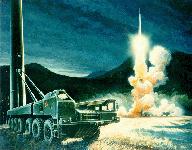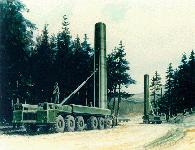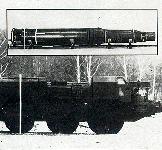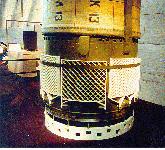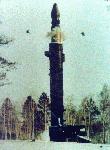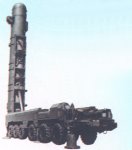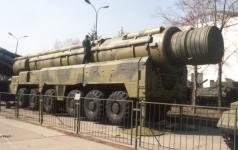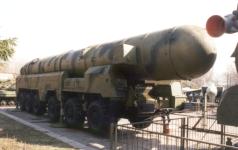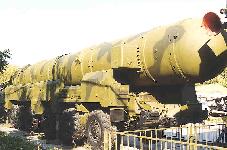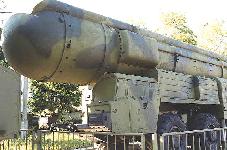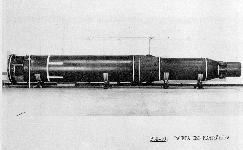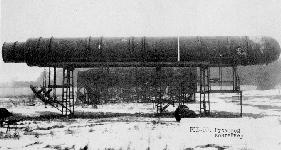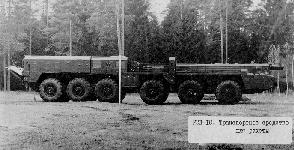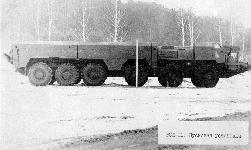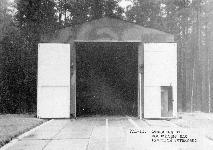




The RT-21M / SS-20 is a solid-fuel, two-stage, theater-based ballistic missile based on the first and second stages of the SS-16. The SS-20 was probably intended to replace or augment the SS-4s and SS-5s deployed in the Soviet Eastern European theater, thus providing approximately three times the number of warheads of the older force.
The two-stage solid-fuel "Pioneer" with single-nozzle sustainers is derived from the first and second stages of the SS-16 ICBM. The cylindrical casings of the sustainer stages are made from composite materials. The solid propellant charge is rigidly fastened to the sustainer body.
The guidance/control system with its onboard digital computer and a gyro-stabilized platform with floating gyros enables the missile to be horizontally positioned and ensures optimal target accuracy. Flight control during the first stage flight is achieved through aerodynamic and jet vanes. During the second stage low temperature gas is injected into the diverging part of the sustainer nozzle.
The missile was deployed in a transport-launch canister, which was installed on a road-mobile launcher. The launcher was equipped with systems needed to ensure constant combat readiness, preparation and firing. The missile could be launched from a sliding roof garage at regimental bases or from field deployed sites. Before ignition the launcher was suspended on a hydraulic support, then the container was set upright in a vertical position. Before ignition of the first sustainer stage the missile was popped out of the container with the help of a solid propellant gas generator the missile and the first stage sustainer was started. The control of launch was conducted from a mobile control center. The SS-20 also has the capability to be reloaded and refired.
The developer of a complex was the Moscow institute of Thermal Technology which was headed by A.D. Nadiradzye. The flight-design tests were conducted from 21 September 1975 through 09 January 1976 at the Kapustin Yar test site. Deployment of the SS-20 began on 11 March 1976, and the first regiment equipped with the Pioneer missiles was set under airborne alert on 30 August 1976.
According to western data, the rocket was tested in three different Mods. The SS-20 Mod1&3 carried a single warhead whereas the SS-20 Mod2 carried a MIRV warhead. The Mod2 equipped with three warheads with a yield of 150 KT each became the standard missile. In this version the warheads are placed on a post-boost vehicle.
On 10 August 1979 the tests of the modernized "Pioneer"-UTTKh (15Zh53) began on the Kapustin Yar test site. They continued through 14 August 1980, and on 17 December 1980 the missile designated as SS-20 Mod3 was deployed. This variant had the same propulsion system as earlier versions, but it due to upgrading of a command structure and instrumentation-service unit it was possible to improve accuracy (CEP) from 550 to 450 meters, to increase maximum range by 10 %, and to increase the area covered by the warheads.
According to some Western assessments, with a new single, lightweight warhead, or with the addition of a third stage (or both), the SS-20 has the potential to be converted to an ICBM with limited capability against the continental United States.
Between 1978 throught 1986 a total of 441 launch complexes for the "Pioneer" missiles were deployed. The SS-20 was one of the missile systems eliminated under the terms of the INF Treaty, which took effect in June 1988. Prior to the INF drawdown, the SS-20 force comprised 48 bases that housed the regularly deployed force of 405 missiles and launchers.
The Intermediate-Range and Shorter-Range Nuclear Forces [INF] Treaty was signed on 08 December 1987 and entered into force on 01 June 1988. The fundamental purpose of the INF Treaty was to eliminate and ban US and former USSR (FSU) ground-launched ballistic and cruise missiles, as well as associated support equipment, with ranges between 500 and 5500 kilometers. The first Soviet SS-20 missile and canister were eliminated under INF Treaty at the Kapustin Yar Missile Test Complex on 22 July 1988. The first Soviet SS-20 missiles were eliminated by launching at the Chita and Kansk missile sites on 25 August 1988. The last of 654 SS-20 missiles was eliminated at the Kapustin Yar Missile Test Complex on 12 May l991. And the last of 499 SS-20 launchers was eliminated at the Sarny Launcher Elimination Facility on 28 May 1991.
Specifications | |||||||
|
Mod-1 |
Mod-2 |
Mod-3 |
|||||
|
DIA |
SS-20 |
SS-20 |
SS-20/SS-X-28 |
||||
|
NATO |
Saber |
Saber |
Saber |
||||
|
Bilateral |
RSD-10 |
RSD-10 |
RSD-10 |
||||
|
Service |
RSD-10/Pioneer |
RSD-10/Pioneer-UTTX |
RSD-10/Pioneer-3 |
||||
|
OKB/Industry |
15Zh45 (Temp-2C) |
15Zh53 (Temp-2C) |
15Zh53 (Temp-2C) |
||||
|
Design Bureau |
Moscow Institute of Thermal Technology |
Moscow Institute of Thermal Technology |
Moscow Institute of Thermal Technology |
||||
|
Approved |
3/4/1968 |
7/19/1977 |
8/14/1980 |
||||
|
Years of R&D |
|||||||
|
Engineering and Testing |
1974-76 |
1974-1976 |
1979-1980 |
||||
|
First Flight Test |
9/21/74 |
9/21/74 |
8/10/1979 |
||||
|
IOC |
1976 |
1976 |
1980 |
||||
|
Deployment Date |
3/11/1976 |
3/11/1976 |
12/17/1980 |
||||
|
Type of Warhead |
Single |
MIRV |
Single or MIRV |
||||
|
Warheads |
1 |
3 |
1/3 |
||||
|
Yield (Mt) |
1.0 |
0.15 |
? |
||||
|
Payload (t) |
1.5-1.74 |
1.5-1.74 |
? |
||||
|
Total length (m) |
16.49 |
16.5 |
17.0 |
||||
|
Total length w/o warhead (m) |
14.9 |
14.9 |
14.9 |
||||
|
Missile Diameter (m) |
1.79 |
1.79 |
1.79 |
||||
|
Launch Weight (t) |
37 |
37 |
37 |
||||
|
Fuel Weight (t) |
|||||||
|
Range (km) |
600-5000 |
600-5000 |
600-5500/7500 |
||||
|
CEP (m) Russian Sources |
0.550 |
0.550 |
0.450 |
||||
|
CEP (m) Western Sources |
150-450 |
400-430` |
? |
||||
|
|
|||||||
|
Number of Stages |
2 |
|
|
Canister length (m) |
19.32 |
|
|
Canister length w/o front (m) |
||
|
Canister diameter (m) |
2.14 |
|
|
Booster guidance system |
Inertial, autonomous |
|
1st stage |
2nd stage |
2nd Stage |
|||
|
Length (m) |
8.58 |
4.4-4.6 |
4.4-4.6 |
||
|
Body diameter (m) |
1.79 |
1.47 |
1.47 |
||
|
Fueled weight (t) |
26.7 |
8.63 |
8.63 |
||
|
Dry weight (t) |
|||||
|
Solid Motor Designation |
|||||
|
Design Bureau |
|||||
|
Years R & D |
|||||
|
Propellants |
Solid |
Solid |
Solid |
||
|
Fuel |
N/A |
N/A |
N/A |
||
|
Oxidizer |
N/A |
N/A |
N/A |
||
|
Burning time (sec.) |
63 |
||||
|
Thrust Sea Level/Vacuum (Tonnes) |
|||||
|
Special Impulse (sec.) |
|
Basing Mode |
Ground mobile |
|
|
Hardness |
||
|
Launching Technique |
Mortar Launch |
|
|
Deployed boosters |
0 |
|
|
Test Boosters |
||
|
Warheads Deployed |
0 |
|
|
Deployment Sites |
INF Treaty data |
|
|
Training Launchers |
||
|
Space Booster Variant |
N/A |

